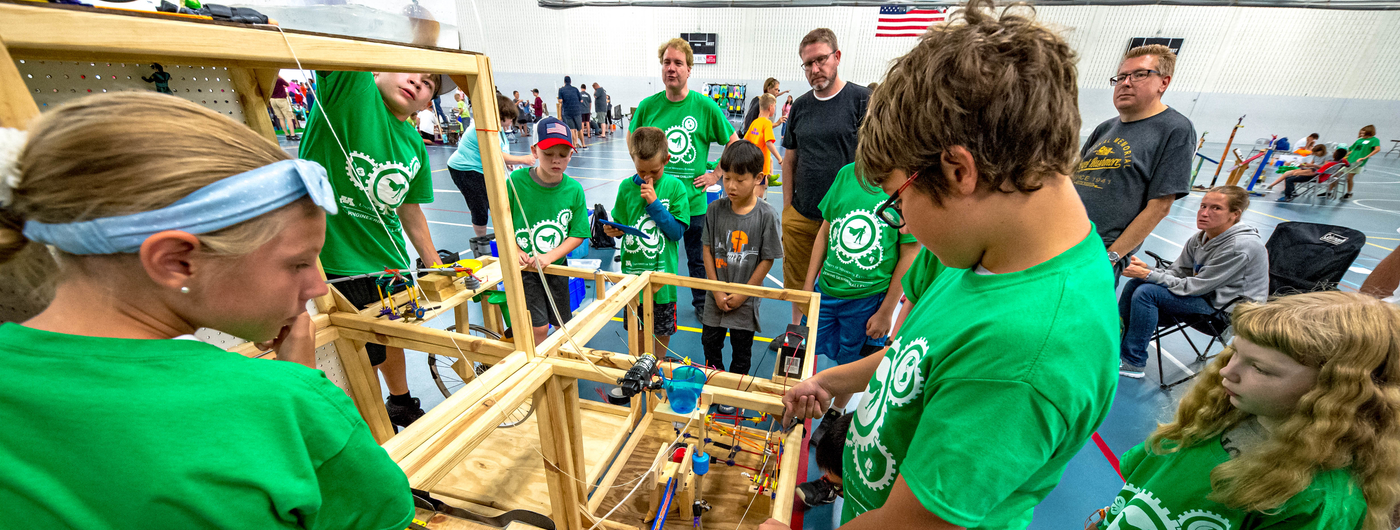What it is
STEM refers to using the four disciplines of science, engineering, technology and mathematics to engage youth in learning experiences through science inquiry, engineering design and the science and engineering practices. Each discipline may stand alone or can be interwoven to provide an educational context that allows youth to engage in hands-on, inquiry-based learning experiences.
Research suggests that non-formal and out-of-school educational settings like 4-H are important in addressing science, technology, engineering, and math (STEM) learning needs. When designed correctly, non-formal and out-of-school STEM programs for youth can:
- Be grounded in reflective practice through implementation of models such as Experiential Learning (Do, Reflect, Apply)
- Provide the opportunity to pursue interest areas in STEM topics
- Focus on growing/expanding attitudes, skills and content knowledge
- Be flexible in the way learning settings are structured
- Foster elements of positive youth development
- Facilitate opportunity to build relationships with their peers who have similar interests
- Accommodate to a variety of learning styles/needs
- Advance exploration of future aspirations
- Avoid the pressures that come with formal education including the expectations to meet an academic criteria or standard
In addition, non-formal and out-of-school STEM settings can foster youth learning and skill building, specifically the 21st Century Learning Skills known as “the four C’s”.
As a whole, these four C’s can help youth develop habits they can put into practice and improve upon throughout their lifetime. Intentionally infusing these learning skills into non-formal STEM settings elevates the overall quality of the learning experience and allows the adult facilitator to raise up opportunities to put these skills into practice.
The four C's
The act of exchanging information. Important because it helps youth:
- Express themselves clearly
- Be open to meaningful exchanges of information with others
- Gain social and emotional learning skills
- Convey their ideas quickly and concisely
- Practice verbal, non-verbal and written ways to express themselves
Working alongside others to achieve a common goal. Important because it helps youth:
- Recognize their personal strengths and areas for growth
- Understand the perspective of others
- Be open minded to new ideas
- Give support and encourage others
- Practice compromise
The process of actively conceptualizing, applying, analyzing and evaluating information. Important because it helps youth:
- Have empathy for others points of view
- Become individual thinkers
- Question what they hear
- Discover personal truth
- Present evidence for ideas
- Identify bias
The act of using imagination to bring original ideas to life. Important because it helps youth:
- Be open to unlimited possibilities
- Increase confidence and self-esteem
- Improve problem solving skills
- Express their thoughts and feelings
- Relieve stress
Why it matters
Building learning skills in youth through non-formal STEM learning settings can address broader global educational and workforce needs. Specifically, they can:
Improve scientific literacy
The knowledge and understanding of scientific concepts and processes required for personal decision making, participation in civic and cultural affairs, and economic productivity.
Address STEM labor force issues
The labor force is aging, women and historically excluded underrepresented racial and ethnic groups, particularly Black and Hispanic populations, continue to display lower participation rates relative to the general U.S. population in the STEM workforce.
Enhance positive youth development
This happens through application of the elements of positive youth development to support social and emotional well being.
What effective practice looks like
In order to accomplish desired outcomes, adults who provide youth with out-of-school STEM learning based experiences need to use a diverse range of proven methods and techniques. Key tips to do so include:
- Give plenty of time for exploration and discovery to take place
- Develop a high quality learning environment
- Focus on group/individual youth interactions
- Allow youth to practice decision making
- Recognize youth for their efforts and growth
- Offer some degree of challenge and risk taking
- Provide open non-restrictive space
- Ask open-ended questions
- Include youth voice/choice
- Find success in failure
Several strategies exist for adults who lead and facilitate out-of-school STEM learning based experiences for youth. To ensure high quality occurs, a few recommendations include:
- Integrate program design models such as Science Inquiry, The Engineering Design Process, and the Science and Engineering Practices.
- Encourage multiple interactions with team members to refine specific roles and responsibilities.
- Develop facilitation skills through practice. Reminder, you don’t have to be an expert.
- Ensure learning is inquiry-based and hands-on. Includes specific learning goals, objectives, outcomes and evaluation.
- Use evaluation to measure youth experience and for program improvement.
- Facilitate science as inquiry and engineering as problem solving.
- Demonstrate there is success in failure.
- Find ways to make real world connections.
- Relate content to the participants' daily lives.
- Arnold, M. (2018). From Context to Outcomes: A Thriving Model for 4-H Youth Development Programs. Journal of Human Sciences and Extension, 6(1), 141-160.
- Compton, R.M., Meyer, R., Stevenson, A. & Somongkol, T. (2021). The Minnesota 4-H Engineering Design Challenge. Journal of Extension.
- Haugen, H., Stevenson, A., & Meyer, R. L. (2016). Participant Comfort with and Application of Inquiry-Based Learning: Results from 4-H Volunteer Training.
- Meyer, R., Meyer, N., Kingery, L., & Clark, R. (2017). Student Readiness for Conservation Careers: Identifying critical skills needed for success in the 21st century natural resource conservation workforce. University of Minnesota.
- National Academy of Sciences, National Academy of Engineering, and Institute of Medicine. 2007. Rising Above the Gathering Storm: Energizing and Employing America for a Brighter Economic Future. Washington, DC: The National Academies
- National Institute of Food and Agriculture. (2021). 4-H Science. United States Department of Agriculture.
- National Science Board. 2015. Revisiting the STEM Workforce, A Companion to Science and Engineering Indicators 2014, Arlington, VA: National Science Foundation (NSB-2015-10)
- Tomovic, C., McKinney, S., & Berube, C. (2017). Scientific literacy matters: Using literature to meet next generation science standards and 21st century skills. K-12 STEM Education, 3(2), 179-191.
Reviewed in 2023


